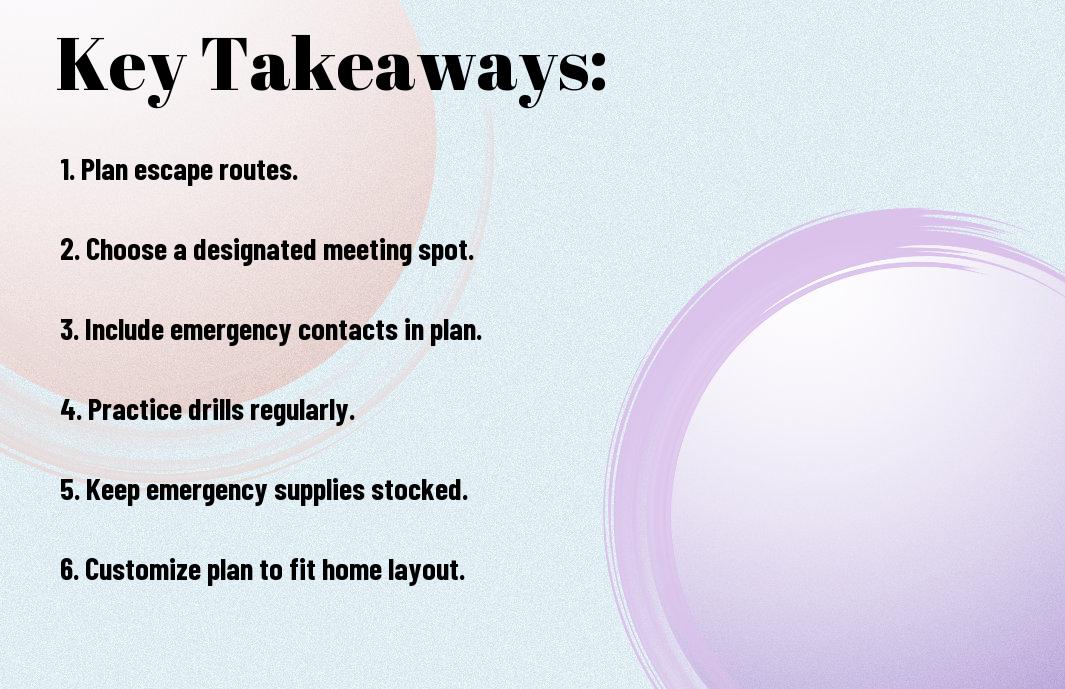Just as a traveler plans for a journey, preparing for emergencies at home is important. In this guide, we’ll outline simple steps to develop a home safety emergency plan. From identifying potential hazards to establishing communication strategies, stay proactive and ready for any unforeseen circumstances. Let’s dive in and build a solid plan to keep your loved ones and property safe.

Identifying Potential Hazards
Assessing Your Home’s Layout
For your home safety emergency plan, start by assessing your home’s layout. Walk through each room and identify potential hazards such as loose rugs, cluttered pathways, or slippery floors. Take note of any furniture that could block exits or pose tripping hazards.
Common Hazards in Each Room
The next step in creating your home safety emergency plan is to identify common hazards in each room. The kitchen, for example, may have sharp knives, hot surfaces, and flammable materials. The bathroom could have wet floors, electrical appliances near water sources, and medications within reach of children.
For instance, the living room may have heavy objects that could fall during an earthquake or breakable items that could cause injury if shattered. By recognizing these potential hazards, you can take proactive steps to minimize risks and ensure a safer environment for you and your family.
Creating an Emergency Escape Plan
It is crucial to have a well-thought-out emergency escape plan in place to ensure the safety of you and your loved ones in the event of a home emergency. The plan should include designated escape routes and safe meeting points outside the home.
Designating Escape Routes
Designating escape routes involves identifying all possible exits from each room in your home. Make sure windows and doors can be easily opened by all family members, including children and the elderly. Clearly mark and keep these routes free of obstructions at all times.
Identifying Safe Meeting Points
Identifying safe meeting points outside the home is crucial to ensure that everyone can be quickly located in case of an emergency. Choose a primary and secondary meeting point a safe distance away from the home, such as a neighbor’s house or a designated spot in the neighborhood.
For instance, a large tree or a specific street corner can serve as easily identifiable meeting points. Make sure all family members are aware of these locations and practice reaching them quickly and safely as part of your emergency drills.
Emergency Contact Information
After creating an emergency plan for your home safety, it is important to compile a list of crucial contact information. In times of crisis, having quick access to important phone numbers can make all the difference in getting the help you need promptly.
Creating a Contact List
Creating a contact list should include emergency services such as police, fire department, and medical emergency services. Additionally, include contact information for your local hospital, poison control center, and any other relevant emergency services in your area. It is vital to have these numbers readily available for quick reference in case of an emergency.
Displaying Important Phone Numbers
Any list of emergency contact information should be prominently displayed in your home where all family members can easily access it. Consider posting it on the refrigerator, bulletin board, or another central location that is easily visible to everyone. Ensuring that this information is easily accessible can help save precious time during an emergency.
The importance of prominently displaying important phone numbers cannot be overstated. In stressful situations, having these numbers clearly visible can help ensure that the necessary help is reached swiftly. Consider laminating the list or putting it in a protective sleeve to prevent damage or wear over time.
Fire Safety Precautions
Now, when it comes to home safety, fire safety should be a top priority. Fires can spread quickly and cause devastating damage, so it’s imperative to have the right precautions in place to protect your household. Here are some key fire safety measures to consider.
Fire Extinguishers and Their Uses
Fire extinguishers are crucial tools in the event of a fire emergency. It’s important to have the right type of fire extinguisher for the specific threats in your home. For example, Class A extinguishers are suitable for ordinary combustibles like paper and wood, while Class B extinguishers are designed for flammable liquids like grease and gasoline. Make sure to place fire extinguishers in easily accessible locations and educate your family members on how to use them effectively.
Fire Drills and Practice
The key to staying safe in a fire emergency is preparedness. The best way to ensure that everyone in your household knows what to do in case of a fire is to conduct regular fire drills. Develop a fire escape plan with designated escape routes and meeting points outside the house. Practice the drills at least twice a year, including different scenarios like fires starting in different parts of the house and during nighttime. This practice will help everyone react quickly and calmly in a real emergency.
Natural Disaster Preparedness
Not sure where to start when it comes to creating a home safety emergency plan for natural disasters? Refer to How to Create an Emergency Action Plan for guidance on how to prepare for various types of emergencies.
Earthquake Preparedness
Earthquake preparedness is crucial for those living in seismically active regions. Secure heavy furniture, appliances, and items that could fall during an earthquake. Create an emergency kit that includes vitals like water, food, first aid supplies, and a flashlight. Develop a communication plan with your family members on what to do during and after an earthquake.
Hurricane and Flood Preparedness
Preparedness for hurricanes and floods involves fortifying your home with storm shutters or plywood, securing outdoor items, and having a plan for evacuation if necessary. Keep important documents in a waterproof container and ensure you have ample supplies of food, water, and medication. Stay informed about weather alerts and follow evacuation orders when issued.
A combination of high winds and heavy rain can result in devastating flooding during a hurricane. Create barriers with sandbags and elevate valuables in your home to minimize flood damage. Be ready to evacuate to higher ground if flooding becomes a threat to your safety.
Tornado Preparedness
Tornado preparedness is crucial for those in tornado-prone areas. Identify a safe room in your home, such as a basement or an interior room without windows, where you can take shelter during a tornado. Keep emergency supplies in this room, including helmets for head protection and a battery-operated weather radio to stay informed about the storm’s progression.
To increase your tornado preparedness, practice tornado drills with your family so everyone knows what to do in case of a tornado warning. Stay vigilant during severe weather conditions and heed tornado warnings by seeking shelter immediately to ensure your safety.
First Aid and Medical Emergencies
Basic First Aid Kit Essentials
Medical emergencies can happen unexpectedly, and having a well-equipped first aid kit at home is necessary. Some basic items to include in your kit are adhesive bandages, sterile gauze pads, adhesive tape, antiseptic wipes, scissors, tweezers, and disposable gloves. It’s also important to have a thermometer, pain relievers, and any necessary prescription medications for family members.
Responding to Medical Emergencies
One crucial aspect of handling medical emergencies is to stay calm and assess the situation quickly. If someone is injured or unresponsive, call emergency services immediately. Administer first aid as necessary and provide reassurance to the person in distress. Remember to never move someone who has possibly experienced a spinal injury unless it’s absolutely necessary to prevent further harm.
Understanding how to properly respond to medical emergencies can make a significant difference in the outcome for the individual in need. Consider taking a first aid and CPR course to gain the skills and confidence to assist in various emergency situations effectively.
Practicing and Updating Your Plan
Scheduling Regular Drills
All emergencies require preparation. Your home safety emergency plan should not just be a piece of paper tucked away in a drawer; it must be a living document that you and your family are familiar with. Schedule regular drills to practice different scenarios such as fires, earthquakes, or home invasions. By physically going through the steps of your plan, you can ensure that everyone knows what to do when a real emergency strikes.
Reviewing and Updating Your Plan
Any good plan should be dynamic and adaptable to changing circumstances. Regularly review and update your home safety emergency plan to reflect any changes in your household, such as new family members, pets, or renovations. It’s also important to take into account any new risks that may arise in your area, such as natural disasters or community safety concerns.
For instance, if you live in a region prone to hurricanes, you may need to include specific evacuation routes and shelters in your plan. By keeping your plan current, you can be better prepared to protect yourself and your loved ones in the event of an emergency.
To wrap up
Now that you have a clear understanding of how to create a home safety emergency plan, remember that preparation is the key to keeping yourself and your loved ones safe in the event of a disaster. Be sure to include all important information in your plan, such as emergency contacts, meeting points, and escape routes. Practice drills regularly to ensure everyone knows what to do in case of an emergency. By taking these steps, you can be better prepared to handle any unexpected situations that may arise.
FAQ
Q: Why is it important to have a home safety emergency plan?
A: Having a home safety emergency plan is crucial because it helps you and your family prepare for unexpected events and emergencies, ensuring everyone’s safety and well-being.
Q: What should be included in a home safety emergency plan?
A: A home safety emergency plan should include evacuation routes, designated meeting points, emergency contact information, important documents, and important supplies.
Q: How often should a home safety emergency plan be reviewed and updated?
A: It is recommended to review and update your home safety emergency plan at least once a year, or whenever there are significant changes in your household or living situation.
Q: How can we involve children in creating a home safety emergency plan?
A: To involve children in creating a home safety emergency plan, you can conduct practice drills, use age-appropriate language, and assign them specific tasks to ensure their active participation and understanding.
Q: What are some common hazards to consider when creating a home safety emergency plan?
A: Common hazards to consider when creating a home safety emergency plan include fires, natural disasters (such as earthquakes or hurricanes), power outages, gas leaks, and medical emergencies.
Q: How can technology be integrated into a home safety emergency plan?
A: Technology can be integrated into a home safety emergency plan by utilizing smart devices for monitoring, alerts, communication, and storing important information digitally for quick access during emergencies.
Q: What should I do if a family member has special needs or mobility limitations?
A: If a family member has special needs or mobility limitations, it is important to tailor your home safety emergency plan to accommodate their specific requirements, including accessible evacuation routes, specialized equipment, and communication strategies.




1 thought on “How to Create a Home Safety Emergency Plan”
Comments are closed.